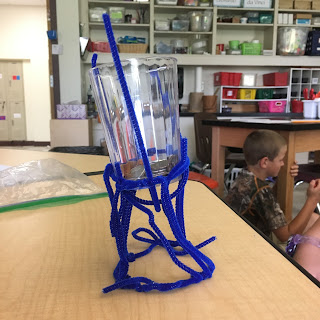Photosynthesis Models
Students created 3D models to show their learning. The final projects were SO AMAZING!! They have once again surpassed my expectations. WOW!
Wednesday, September 28, 2016
Friday, September 23, 2016
Me and My Shadow
I am very happy we measured shadows on Wednesday! Yesterday would have been okay but Wednesday was perfect! We saw even saw the moon and took pictures to see it move across the sky. It was interesting to the students to see how the shadows were long in the morning and grew shorter towards lunch time and then grew long again. This was a cooperative effort between all three cores because they shared the paper that recorded the data. Yesterday we then graphed the data. The purpose is to see that the Earth has predictable patterns. I am wondering how a sundial would look on our school grounds.
Tuesday, September 20, 2016
Saturday, September 17, 2016
Wednesday, September 14, 2016
Students have been working hard to learn the many components that come together to create a "Food Chain." They have learned that all food chains start with a "producer" which is a plant that gets it's energy from the sun through photosynthesis. Primary and Secondary Consumers eat the Producers. Consumers can continue the flow of energy until they die, when "decomposers" help break down the animal or plant which returns them to soil to help the producer grow all over again! Today students explored the three main types of Consumers: Omnivores, Herbivores and Carnivores. Here they are, sorting many animals. We all found that we had at least one misconception about what animals eat!
Rotation Rotation Rotation
It takes only 8 minutes for the Sun's energy (heat and light) to reach our planet even though it is 92,000,000 miles away! The Sun is our star and even though it looks like the biggest star in the Universe, it is only medium size. Why all this talk about the Sun? The students are learning about the Earth's rotation which causes day and night. We use this to help measure time. So we have been practicing rotating (spinning)(Time: 24 hours) and we will see how this is very different this is from revolving which is the Earth moving around the Sun (Time: 1 year)
Tuesday, September 13, 2016
Today, one group of students planted bean sprouts so we can watch them grow under different circumstances. We have water vs. no water, sunlight vs. no sunlight, air vs. no air and different types of soil. We will continue to observe over the next couple of weeks, so stayed tuned...
We also started the discussion about how plants get water. We dissected stalks of celery and made some amazing observations. We will start to talk about the parts of a plant and how energy from the sun feeds the plants.
We also started the discussion about how plants get water. We dissected stalks of celery and made some amazing observations. We will start to talk about the parts of a plant and how energy from the sun feeds the plants.
Thursday, September 8, 2016
Wednesday, September 7, 2016
What are we doing?
Science and technology spaces (classrooms, labs, maker spaces, design studios, and project spaces) need to be designed to prepare future generations of integrative problem-solvers with the purpose of inspiring students to learn, explore, and discover in order to develop a deep understanding and appreciation of how to solve authentic problems.
Science and technology spaces (classrooms, labs, maker spaces, design studios, and project spaces) need to be designed to prepare future generations of integrative problem-solvers with the purpose of inspiring students to learn, explore, and discover in order to develop a deep understanding and appreciation of how to solve authentic problems.
Our current Science and Social Studies teachers in grades 3, 4 and 5 have been challenged with redesigning their three classrooms to support our BFA Innovative initiative. These spaces include a Digital & Thinking/Creating Space, Engineering Construction/Deconstruction Space and a Prototype Testing & Whole Group Activity Space.
The teachers along with support from Rhonda Siemons, our Technology Integration Specialist, have been actively researching what other successful institutions have done. They recently visited Woodstock Elementary’s STEM Lab, Starbase, and the UVM FABLAB. These teachers along with the new BFA Ninth Grade Academy teachers are in the early stages of forming a partnership with UVM’s Engineering Department where members of their staff have agreed to support our initiative. In addition to supporting our team of teachers, college students will serve as mentors to our BFA students.
To borrow UVM’s philosophy around their new STEM building: “The (grades 3-5 space) needs to be highly flexible, rapidly adaptable, and infinitely reconfigurable – to accommodate changing needs, evolving priorities, and new opportunities.” It is our belief that we will become an even more successful school by making science, engineering, math, technology the foundation for learning history and literacy.
UVM, The Case for STEM - “The STEM Complex we envision is not extravagant, it is essential. It is not isolating, it is engaging. It is not boastful, it is optimistic.”
BFA Elementary Innovation Lab
VISION:
In society, scientific literacy and technical competency are essential for every citizen to have in order to understand the problems facing the planet and to participate successfully in the work world. BFA’s Elementary Innovation Space is an exciting initiative where students will develop their communication, problem solving, creativity, perseverance and collaboration skills through authentic learning challenges.
Subscribe to:
Posts (Atom)





























